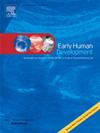Genetic features of alveolar capillary dysplasia with misalignment of pulmonary veins in Japanese infants
IF 2
3区 医学
Q2 OBSTETRICS & GYNECOLOGY
引用次数: 0
Abstract
Background
The genetic features of alveolar capillary dysplasia with misalignment of pulmonary veins (ACDMPV) among infants in Japan have not been extensively evaluated.
Methods
This study enrolled sixteen infants with pathologically confirmed ACDMPV. DNA was extracted from the peripheral blood cells of the infants for genetic analysis. The samples from tree infants were not viable for analysis, so only 13 were analyzed. Sanger sequencing or next-generation sequencing of the FOXF1 coding exon was performed on the samples. When causative variations were not identified, the multiplex ligation-dependent probe amplification (MLPA) method was used to identify copy-number variations (CNVs) in the exons and the upstream region of FOXF1.
Results
The causative lesions included three missense, one nonsense, and two frameshift variations from six (46 %) participants. CNVs were detected in the DNA samples of five (38 %) participants. No relevant genetic lesions were identified in the remaining two (15 %) cases. The father and two siblings of one affected infant exhibited the same CNV in the upstream region of FOXF1.
Conclusion
We have previously reported cases of ACDMPV patients diagnosed by molecular analysis without pathological confirmation in Japan. This article is the first to report the genetic features associated with pathologically confirmed ACDMPV among infants in Japan.
日本婴儿肺泡毛细血管发育不良伴肺静脉错位的遗传特征
背景:日本婴儿肺泡毛细血管发育不良伴肺静脉不对准(ACDMPV)的遗传特征尚未得到广泛评估。方法本研究纳入16例经病理证实的ACDMPV患儿。从婴儿的外周血细胞中提取DNA进行遗传分析。来自树苗的样本无法进行分析,因此只分析了13个。对样品进行FOXF1编码外显子的Sanger测序或下一代测序。在未确定致病变异的情况下,使用多重连接依赖探针扩增(MLPA)方法鉴定FOXF1外显子和上游区域的拷贝数变异(cnv)。结果6例(46%)参与者的致病病变包括3例误义、1例无意义和2例移码变异。在5名(38%)参与者的DNA样本中检测到CNVs。其余2例(15%)未发现相关遗传病变。一个患病婴儿的父亲和两个兄弟姐妹在FOXF1上游区域表现出相同的CNV。结论我们之前报道过日本的ACDMPV患者通过分子分析诊断,但没有病理证实。本文首次报道了日本婴儿病理证实的ACDMPV相关的遗传特征。
本文章由计算机程序翻译,如有差异,请以英文原文为准。
求助全文
约1分钟内获得全文
求助全文
来源期刊

Early human development
医学-妇产科学
CiteScore
4.40
自引率
4.00%
发文量
100
审稿时长
46 days
期刊介绍:
Established as an authoritative, highly cited voice on early human development, Early Human Development provides a unique opportunity for researchers and clinicians to bridge the communication gap between disciplines. Creating a forum for the productive exchange of ideas concerning early human growth and development, the journal publishes original research and clinical papers with particular emphasis on the continuum between fetal life and the perinatal period; aspects of postnatal growth influenced by early events; and the safeguarding of the quality of human survival.
The first comprehensive and interdisciplinary journal in this area of growing importance, Early Human Development offers pertinent contributions to the following subject areas:
Fetology; perinatology; pediatrics; growth and development; obstetrics; reproduction and fertility; epidemiology; behavioural sciences; nutrition and metabolism; teratology; neurology; brain biology; developmental psychology and screening.
 求助内容:
求助内容: 应助结果提醒方式:
应助结果提醒方式:


